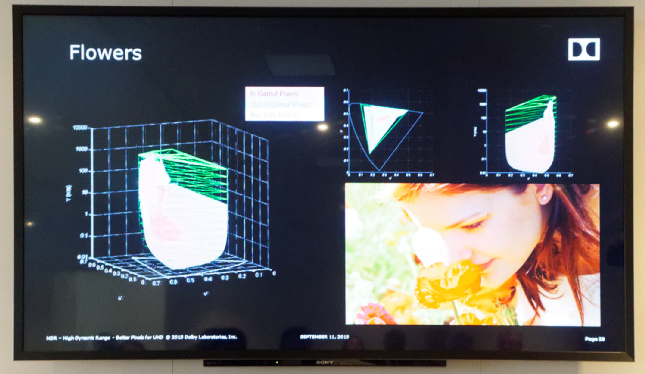 Dolby gave a talk as one of the SES seminars at the event. Arnd Paulsen of Dolby started by talking about human vision and its capabilities. The aim is to deliver content that matches that capability. However, moving the content across the networks and delivery systems, the contrast and gamut becomes very limited – which is because the CRT was the limit in the past, when the standards were defined. Now, displays are capable of much more.
Dolby gave a talk as one of the SES seminars at the event. Arnd Paulsen of Dolby started by talking about human vision and its capabilities. The aim is to deliver content that matches that capability. However, moving the content across the networks and delivery systems, the contrast and gamut becomes very limited – which is because the CRT was the limit in the past, when the standards were defined. Now, displays are capable of much more.
In the cinema – the peak brightness is defined at 48 nits and darkness at 0.024 nits, which is just 11 f stops of dynamic range. When you then move that to TV, you reduce the gamut to Rec. 709, rather than P3 – but the brightness goes up to 100 nits, so you have to “stretch” the signal. The latest displays have much better capability than the CRT and so sets use their “best guess” to uprate the content to more nearly match the display.
One solution to this problem is to transmit metadata with the signal to indicate the original contrast and colour so that the set can intelligently get as near as possible to the original. HDTV uses Rec. 709 as the colour gamut, which was defined in April 2002. BT.1886 (March 2011) defines a reference EOTF to allow an LCD to simulate a CRT. Brightness was just 100 cd/m² in the Rec. 709 recommendation. Grading is performed based on brightness of 100 cd/m² because that was about the maximum that a good CRT could create.
SMPTE has now defined a new EOTF (ST 2084) based on the PQ curve. The BBC/NHK also have a proposal for a hybrid log gamma. ST2086 defines static metadata that can be sent to a device to indicate the overall parameters of the content for the guidance of the display device. Another standard, SMPTE WD 2090 describes dynamic metadata (scene by scene).
HDMI 2.0a supports static metadata (PQ & ST2086) to allow the support of basic HDR delivery.
Paulsen described the test setup that Dolby used when developing its system – it was capable of extreme brightness and Dolby found that 80% of people liked 10,000 cd/m² of peak brightness and only 5% like Rec. 709. 90% prefer HDR to SDR. He then looked at colour and he spent some time on the issue of colour volume. Colour is three dimensional, whereas a CIE curve is two dimensional. What is not clear from a CIE chart or a gamut percentage is what colours are available at different brightness levels.
The problem is that many saturated colours are not available at higher brightness in typical consumer displays. He compared the colour volumes of a number of enhanced displays to the content that was being shown. In many cases, although colours were in gamut, at high brightness, the colours could not be displayed, so detail in the images is lost.
 Paulsen showed a number of examples of images where the gamut matched, but the colour volume didn’t, as many colours are not available at high brightness
Paulsen showed a number of examples of images where the gamut matched, but the colour volume didn’t, as many colours are not available at high brightness
In the Dolby scheme, all the data on colour and brightness gets to the end of the delivery chain. Further, an HDR TV programme is created independently of the cinema version, rather than simply being a squeezed version of the content.
If you get the right data to the set and then sort out the colour volume issues, HDR allows detail in the shadows and highlights that is currently lost.
Paulsen said that the BBC and NHK have combined their proposals for a “hybrid log gamma” curve. There are other proposals, and ways of creating HDR content from Technicolor, Philips and Sony has its SLog3 curve.
The challenge for everyone is to broadcast a single signal that works on all TVs to meet the needs of broadcasters, who simply do not want to, and will not, run with multiple streams of content. They need a single stream that looks fine on an existing set, but looks great on an HDR set.

